|
FLURRY AT FOX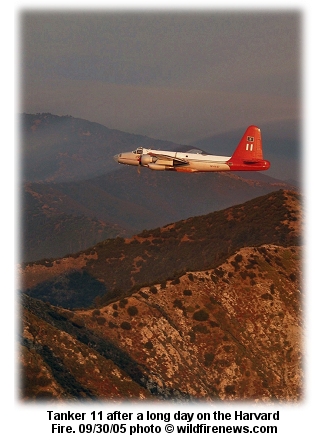 OCTOBER 06 -- LANCASTER, CA: OCTOBER 06 -- LANCASTER, CA:
It's been a busy week for Clay Myers, managing airtanker operations at Fox airtanker base in southern California. Eleven planes have worked fires this week out of Fox.
"We've been working on three fires simultaneously," he said.
Myers told the Antelope Valley Press that fires in San Bernardino County and Burbank and along the border of Los Angeles and Ventura counties all needed air support at the same time.
A dozen of the 17 federal tankers are now in southern California, most of them at Fox.
Myers said most of their efforts lately focused on the Topanga Fire; one tanker made 11 drops in one day on that fire. Operations have been running from 6 a.m. to 9 p.m. lately.
The Harvard Fire was contained earlier this week at 1,094 acres; it burned mostly brush and grass in and around Burbank, and caused mandatory evacuations. The fire threatened residential areas, electrical transmission lines, and communications facilities.

BORDER FIRE ADVANCES ON TOWNOCTOBER 06 -- TECATE, CA: A fast-moving fire south of the Mexican border burned over into California this morning, and has grown to 2,100 acres with about 10 percent containment. The Border #50 Fire started three miles southwest of the Tecate border crossing after flames from a burning structure spread into dry brush.
The Union-Tribune reported that a strike team of five CDF brush rigs had crossed into Mexico to anchor the fire from behind. They worked with municipal firefighters from the Mexican city of Tecate, Baja California state forestry firefighters, Mexican soldiers, and local volunteers.
The fire was burning at Tecate Peak, a site sacred to Kumeyaay Indians on both sides of the border.
The community of Dulzura will be threatened if the fire continues to move west and north. Fire managers expect the fire will threaten outlying homes and ranches along Highway 94 near Dulzura. The fire grew to the west and north last night, then pushed past Cottonwood Creek and jumped firelines. It's spreading west along the border this morning and moving toward homes at the east end of Dulzura. Over 700 firefighters are assigned.

FIRE CLOSES CALIFORNIA FREEWAYOCTOBER 06 -- CALIMESA, CA: A fire in northern Riverside County has grown to 6,000 acres today, according to the Mercury-News, and is now 25 percent contained. Crews were burning out brushy areas near homes early this morning before Santa Ana winds pick up as expected later in the day.
The Woodhouse Fire was 5 percent contained yesterday afternoon at 1,000 acres, burning near San Timoteo Canyon Road at Fishermans Retreat, and residents of about 20 homes were urged to evacuate yesterday. Fire crews were working to reopen the 60 Freeway near San Timoteo Canyon, which was closed yesterday. The City of Moreno Valley was threatened, and the freeway was closed between Beaumont and Moreno Valley. San Timoteo Canyon Road was also closed between I-10 and Redlands Blvd.
The fire started about 3 p.m. yesterday and threatened about 100 homes and five commercial properties. About 570 firefighters are assigned, with 60 engines, seven dozers, four airtankers, and six helicopters. The fire burned to within a quarter-mile of structures, and a natural gas pipeline was also threatened. Fire managers reported that the Southern California Edison main electrical transmission lines for L.A. County were threatened, and the Burlington Northern Santa Fe Railroad route was shut down.

IT'S SANTA ANA TIMESEPTEMBER 29 -- CHATSWORTH, CA: Hundreds of San Fernando Valley residents were evacuated last night as the season's first serious brushfire tore across ridges, pushed by hot Santa Ana winds that the L.A. Times reported at more than 40 mph. More than 980 firefighters worked to contain the fast-moving Topanga Fire, one of a series that started yesterday in the eastern Ventura County and Santa Clarita Valley areas.
The L.A. Daily News reported that one firefighter was struck by a large falling boulder. He was in stable condition at a local hospital and was expected to be released last night. The paper reported the fire at 3,500 acres this morning; officials said it was at 500 acres yesterday evening and the Associated Press this morning reported the fire at 9,300 acres. KCAL-TV reported the fire by mid-day at 17,000 acres.
The fire's threatening powerlines and the Rocky Peak transmitter site; Southern Pacific's rail line and the 118 Freeway were closed. The fire's burning in heavy chaparral with long-range spotting; about 1,500 people were evacuated.
Three homes were destroyed and about 1,000 were threatened; the fire was burning on both the north and south sides of the closed freeway, resulting in huge traffic jams across the valley. Metrolink trains on the Ventura County line were ordered to slow from their normal 50-70 mph in the area down to 20 mph in the fire area, causing transit delays.
The fire started early in the afternoon near Topanga Canyon Boulevard and the 118 Freeway. A smoke plume was visible from the Los Angeles Basin, and ash was falling as far away as Westlake Village. Northeast of Moreno Valley, the 1,330-acre San Timoteo Fire was threatening about 200 homes; crews were working to keep the fire from crossing San Timoteo Canyon Road. The fire yesterday had jumped Redlands Blvd. and was moving west toward the city of Moreno Valley. Voluntary evacuations were under way.

FIRE RETURNS TO THE BOBSEPTEMBER 26 -- KALISPELL, MT: Dozens of fires in the Bob Marshall Wilderness over the last ten or fifteen years have been "good fires," those allowed to burn for resource benefits, the kind of natural historic fires that shaped the wilderness and its ecosystems for centuries before the intensive fire suppression of the last 90-some years.
Earlier this month, according to a feature story in the Daily Interlake, there were six fires burning in the Bob. More than 20 percent of the land in the wilderness has burned over the last 20 years. Wildfire is finally resuming its natural role, says Steve Wirt, fire management officer on the Spotted Bear Ranger District of the Flathead National Forest.
"When you look at the mosaic of fires that have burned over the last 20 years," he says, "it's probably very similar to what occurred in the 1800s. Not a whole lot of fires occurred in the wilderness from 1929 to 1985."
Dave Bunnell, retired Forest Service national fire use program manager, figures that just 3,000 acres burned between 1934 and the early 1980s on the 1.5 million acres of the Bob Marshall Wilderness Complex. But since 1981, more than 340,000 acres have burned over the same area.
Bunnell and a handful of others eventually questioned the policies that had kept fire from the wilderness for so long. He says those advocating for natural fire use 20 years ago were "kind of outlaws" in the agency.
"It was a major change in Forest Service culture," he says. "Fire control is very easy to understand; it's a black-and-white world. Fire management is a very different world, with lots of gray." Bunnell oversaw the 1985 Charlotte Peak Fire, which burned 5,500 acres and set a benchmark for fire operations in the Bob and other wilderness areas.
This summer's Granite Complex, on the Idaho side of Hells Canyon, burned over 35,000 acres early in September. It was allowed to burn for nearly a month within its "management boundary," but when it began threatening that boundary, a Type 2 team was brought in for suppression of the perimeter.
Many such fires are ignited naturally by lightning; others are intentionally set as prescribed fires. The Lewis and Clark National Forest is host to the largest prescribed burns ever done in wilderness areas, creating buffer areas to prevent small wildfires from escaping into huge fires. Two years ago the L&C; burned about 6,000 acres in the Sun River drainage, and they're planning another 4,000 acres this fall.
Prescribed fires and fire use incidents help keep wildfires in the wilderness to a more historically natural size and intensity. "I feel more and more confident that these large-scale, continental-type fires have less chance of running," says Bunnell. "With the large amount of burning we've been able to accomplish in the Bob, the chance of that occurring is less and less."

A HOME BUILT FOR FIRESEPTEMBER 25 -- MEDFORD, OR: Retired forester Rich Fairbanks knows fire, and he knows fire will happen in the forest around the home he built. But he decided fire didn’t have to burn his home, and he built it to be ready for the inevitable.
He used as little wood as possible, with minimal sills, decks, and eaves, according to a feature in the Mail-Tribune. Fairbanks figures chances are excellent that the forest around him will burn, but because there’s no fuel near the house and its surfaces are flat and fire-resistant, he's maximized his chances of saving the home.
Brett Fillis, district fire chief, says constructing a home like Fairbanks did maximizes your chances, but a rural home in the trees will never be entirely safe from fire. "But you have to temper that with the understanding that you’ve increased the likelihood of your home’s survival up to the 95th percentile. You can never guarantee 100 percent safety from fire."
Fairbanks worked for three decades for the U.S. Forest Service, including work on a BAER team after the half-million-acre Biscuit Fire in 2002. Fairbanks knows fire, and he says the first line of defense is the roof. Using a shake or wood-shingle roof, he says, is "asking for it." Roofs of metal, tile, or synthetic material that's UL-rated class A are fire-resistant -- and are mandatory on new construction. The Fairbanks roof is copper. He's also got a high-pressure pump on his well and a firehose he scored on eBay.
Fillis says rural homeowners are more knowledgeable about fire safety than they used to be. A survey of homes in the area last year showed 87 percent of residents had cleared the land around their homes -- and this year it rose to 93 percent.
Under Oregon's wildland/urban interface legislation -- SB360 -- the state can collect up to $100,000 in suppression costs from a landowner if a fire starts on the property or spreads across the property -- and it was not certified as being cleared of fuels. The cost collection may be greater than $100,000 if a landowner is found to be willful, negligent, or malicious in the origin of the fire. For more information, check out the Oregon Department of Forestry pages.

FIRE NEAR IMNAHA BURNS 1,850 ACRESSEPTEMBER 20 -- IMNAHA, OR: The Turner Creek Fire was reported Wednesday morning about 10 miles south of Imnaha; it's burning in the Imnaha Canyon, and Lunde's Type 2 team reported it 25 percent contained last night at 1,850 acres.
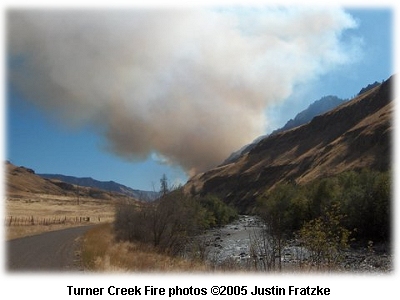 The fire started on private lands, according to the Oregon Department of Forestry, and then jumped onto U.S. Forest Service lands. Reported resources included three helicopters, four engines, and four hand crews.
The fire started on private lands, according to the Oregon Department of Forestry, and then jumped onto U.S. Forest Service lands. Reported resources included three helicopters, four engines, and four hand crews.
Two airtankers dropped on the fire yesterday, and bucket drops by Type 1 and Type 2 helicopters continued throughout the day. The fire was burning mostly in timber stringers in creek drainages, with grass understory. On the exposed slopes, fuels are primarily grass with some scattered brush.
The upper two-thirds of the fire is inaccessible, burning in steep country intersected with deep ravines and canyons, so air attack will continue today on that portion of the fire.
The cause of the fire is under investigation.

AIRTANKER SPLITS COLORADO FIRESEPTEMBER 21 -- STORM MOUNTAIN, CO: Within hours of the 2:20 p.m. call, firefighters had the Storm Mountain Fire beaten into submission. Two SEATs, a heavy airtanker, more than 40 firefighters, and a couple helicopters attacked the fire, and by 8 p.m. it was contained at under 10 acres.
Dave Giles, Big Thompson Canyon fire chief, told the Daily Times-Call that he saw the smoke from where he works in Windsor. Merlin Green, battalion chief with the Loveland Fire and Rescue Department, said that retardant dropped from a large airtanker split the fire into two smaller fires, which made it easier to contain.
Four years ago, the Bobcat Fire, which started from an abandoned campfire in the same area, burned 10,600 acres and 22 structures and forced 350 residents from their homes.
Local resident Lori Shaffer said she was worried about her propane tanks stored near the fire. But she spoke with Giles and was reassured. “I trust my fire guys,” she said. “Dave said not to panic.”

NEW MEXICO RESIDENTS GO HOMESEPTEMBER 21 -- EL RITO, NM: El Rito residents evacuated ahead of the Pine Canyon Complex were allowed to return home yesterday afternoon; 140 homes were threatened and about 80 residents were evacuated Sunday. More than 350 firefighters are on the fire, which was 50 percent contained last night at 3,297 acres.
Whitney's Type 1 team says the fire was human-caused. The Santa Fe New Mexican reported that the fire started from six different ignition sites, all along Forest Road 137 on the west side of Madera Canyon.
Crews are conducting burnouts today. Fire managers are planning for containment on October 1 and will begin demobe of excess resources today.

THINNED AREA DROPS FIRE TO ITS KNEESSEPTEMBER 20 -- EUREKA, MT: The line down the middle of the aerial photo is obvious: black forest on one side, green forest on the other.
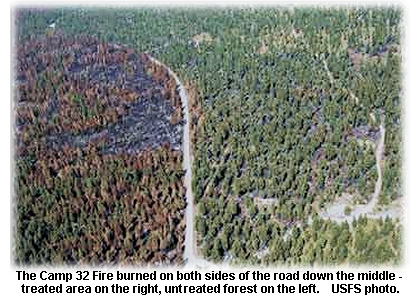 Ron Hvizdak, fire management officer on the Kootenai National Forest, has been using fire to fight fire for decades, but what happened on the Camp 32 Fire this summer dramatically illustrated how thinning and prescribed fire can stop a crowning wildfire. Ron Hvizdak, fire management officer on the Kootenai National Forest, has been using fire to fight fire for decades, but what happened on the Camp 32 Fire this summer dramatically illustrated how thinning and prescribed fire can stop a crowning wildfire.
Four years ago, Hvizdak and staff thinned about 600 acres near Eureka. They cut back the Doug-fir and removed ladder fuels to restore the area to its historic composition of fire-resistant ponderosa pine and larch. Two years later, according to a feature by the Missoulian, they burned out the forest floor, torching out the fine fuels and fir seedlings.
When the Camp 32 Fire took off on adjacent national forest land in early August, it was crowning and headed for a neighborhood of rural homes. When the fire hit the 600-acre thinned area, though, it dropped to the ground. Flamelengths of 100 feet and more shrank to one foot or less. The fire crept along the forest floor. Crews, airtankers, and helicopters hit it hard, and they stopped it less than 100 yards from the homes. The fire was contained at just under 900 acres on August 11.
The Camp 32 Fire burned fast and hot through the untreated forest, but left a mosaic of scorched grass on Hvizdak's 600 acres. With a thinning and burning budget of only $250,000 a year, though, projects are limited. Hvizdak has focused such projects on areas that are prime candidates for treatment, especially those near homes.

NEW MEXICO FIRE EVACUATES EL RITOSEPTEMBER 19 -- EL RITO, NM: Residents were ordered out yesterday afternoon by fire managers on the Pine Canyon Complex west of El Rito -- about 40 miles northwest of Santa Fe. Winds pushed the fire to within 100 yards of homes yesterday.
Crews were were pulled off the fireline to set up structure protection, and airtankers laid retardant between the homes and the advancing fire. Suazo's team reported zero containment at 1,200 acres, and crews reported 200-foot flamelengths at the head of the fire. Whitney's Type 1 team has been ordered.
KRQE-TV, which has some GREAT video online, reported that dozers worked the fire through the night.
The New Mexican reported that the fire was called in Saturday evening by a woman who spotted smoke; by 9 p.m. the fire was estimated at 40 acres, and it grew to 300 acres by Sunday morning. Smoke plumes could be seen from miles away. About 150 people are on the fire.

MAN WHO STARTED IDAHO FIRE MAY BE CHARGEDSEPTEMBER 19 -- MOUNTAIN HOME, IDAHO: A Tipanuk resident whose burn barrel ignited a large fire could face fines or charges, officials say, after the fire between Boise and Mountain Home burned 3,900 acres and caused the evacuation of about 300 people. The fire started Friday evening, according to Sommers Gerratt with the BLM, when a man dumped smoldering trash from a burn barrel on his property. Wind blew sparks into nearby grass and the fire took off.
The Bown's Roost Fire was contained Saturday evening. According to AP reports, about 100 firefighters worked on the fire, helped out by a steady rain Friday night.
It was the second fire this month in Idaho that was ignited by a resident's burn barrel.
The Valley Road Fire evacuated about 50 people in the Fisher Creek area southeast of Stanley in early September, and eventually burned more than 40,000 acres on the Sawtooth National Forest. The Idaho Statesman reported last week that the fire closed Idaho 75 between Stanley and Clayton and evacuated homes near the Robinson Bar Ranch. The fire was at 28,000 acres Friday morning -- up from 15,000 the day before -- burning in bug-killed lodgepole and slash. By Saturday the fire was 85 percent contained at 40,868 acres.
The fire was threatening T&E; species, including bull trout, salmon, wolf, wolverine, and lynx habitat. Public camping areas were also threatened. Sexton's Type 1 team handled the fire; they turned it over to a Type 3 team on Friday.

REST KENNETH REST!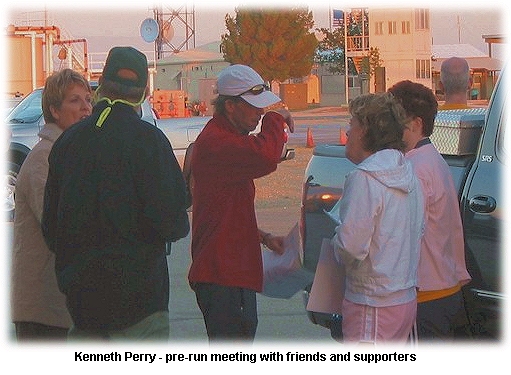
SEPTEMBER 10 -- LANCASTER, CA: Kenneth Perry's 52-mile run for the money was completed today with an official time of 10 hours and 20 minutes. Perry reached the halfway point by about noon today -- and he was well over halfway to his goal of raising $52,000, with over $44,000 pledged this afternoon.
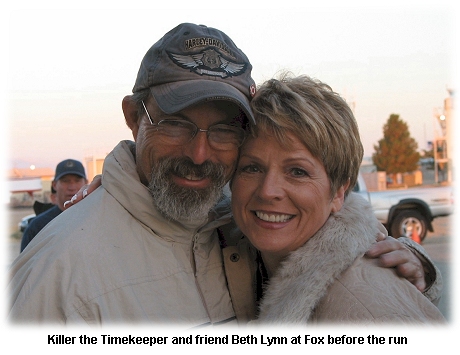
Several companions started the run with him, including a couple of Texas Canyon Hotshots, with members of the Bear Divide Hotshots also planning to keep him company for parts of the run.
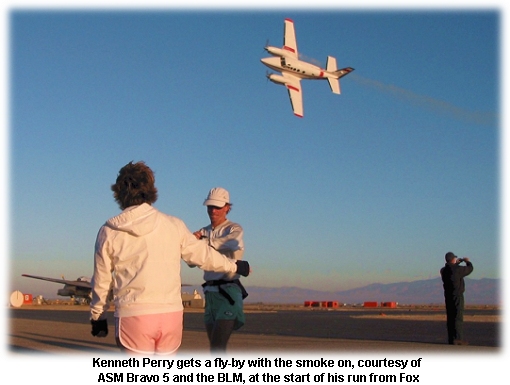
Perry got a great send-off for the start of his run -- a fly-by with the smoke on courtesy of his flying partner Mike Lynn in a turboprop Beech 65-A90-1 -- one of the aircraft flown by air tactical supervisors for the BLM out of Fox Air Attack Base. (Mike Lynn, by the way, also provided these photos -- THANKS Mike!)
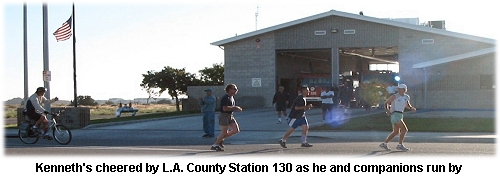
Perry got cheers and greetings as he passed the L.A. County Fire Station 130 south of Fox.
An Air Tactical Supervisor for the BLM, Perry decided to make the 52-mile run for the Foundation's 52 Club, the premise of which is to donate a buck a week to help injured firefighters or those killed in the line of duty and their families.
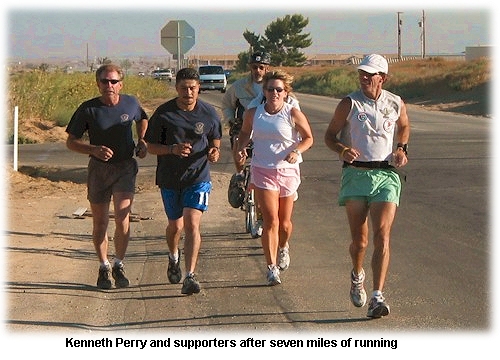
It's not too late to make a pledge in support of Perry's run for the money. Check the SUPPORT page on the Foundation website, and note on the form that you're pledging in support of Kenneth Perry's run. Check the pledge list and running totals at the pledge list page generously hosted by wildlandfire.com, or use their pledge entry form for instant updates to the list. There are maps, photos, and other cool updated stuff about the run on that page, and further updates will also be posted here.
Perry's run was reported on today by the Associated Press.

WASHINGTON FIRE RIPS OVER 1,000 ACRES,
EVACUATES SIX HOMESSEPTEMBER 09 -- METHOW, WA: A fast-moving fire in Okanogan County forced the evacuation of six homes, threatened ten more, and destroyed one building; the Squaw Creek Fire started about 4 p.m. yesterday southwest of Methow. The Seattle Times reported that it was estimated at more than 1,000 acres by early this morning.
Wonch's Type 3 team reported that the fire was at 600 acres late last night with zero containment. The fire spread rapidly to the northeast, running and spotting in the lighter fuels and torching in timber. The fire jumped a dozer line late in the evening.
About 7:30 p.m. four strike teams of state engines were ordered. Reed and Holloway's Type 2 team will take over the fire today.

PERRY'S SATURDAY RUN: ALMOST $33,000SEPTEMBER 07 -- LANCASTER, CA: On September 10 -- that's Saturday -- Kenneth Perry will set out from Fox Air Attack base at Lancaster for a 52-mile run to raise funds for the Wildland Firefighter Foundation.
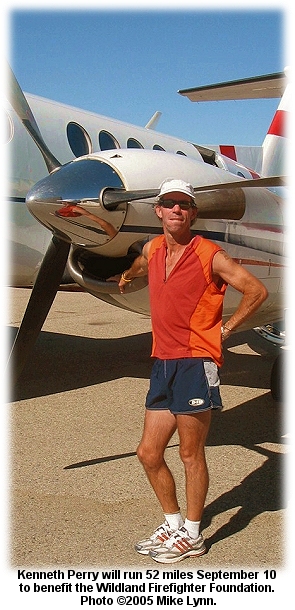 Pledges are being sought by the Foundation in support of Perry's "run for the money." Pledges are being sought by the Foundation in support of Perry's "run for the money."
An Air Tactical Supervisor for the BLM, Perry decided to make the run for the Foundation's 52 Club, the premise of which is to donate a buck a week to help injured firefighters or those killed in the line of duty and their families.
Perry's background includes smokejumping in Alaska and duty with the Fulton Hotshots on the Sequoia National Forest and the Kern County Fire Department. Five years ago he injured his back during a rescue operation in Alaska; even after a couple of surgeries he still deals with constant back and hip pain -- but he's found that long-distance running doesn't make his back any worse, and on Saturday he'll pull in over $600 for each mile he runs.
Perry and the Foundation are asking for pledges on a “per mile” basis in support of the 52-mile run, and today his fundraising potential for the 52 miles topped over $32,696. (!!!)
Notable pledges include Linda and Larry Shirley, who pledged $19.23 per mile "in loving memory of Retha," a pledge of $10 per mile from NorthTree Fire, another $10 per mile from Shawn Srader of the Hat Creek Ranger District on the Lassen, and numerous pledges from members of the SoCal IIMT #1 and SoCal IIMT #3 (award for IMT gang attack here -- you guys put the other teams to shame!!) and a real crew rally from the Chester Helishots. Smokejumpers are kicking in chunks of their paychecks, notably $5.77 per mile pledged from Wayne Risseeuw of the Redmond Smokejumpers, and a whopping $14 per mile from the McCall Smokejumpers (good on you jumpers there). The Arroyo Seco Crew #5 have been all over the donation page, the Redding jumpers got in for another five bucks per mile, and Ron Bollier with the Fulton Hotshots put in $10.10 per mile, just edging out the $10 per mile pledged by both Pete Coy of the Mill Creek Hotshots and Zach Snyder of the Del Rosa Hotshots. The Bear Divide Hotshots doubled those pledges with $20 per mile, and the great folks at the Supply Cache also chipped in for $20 per mile.
And then there's the pledge from "The Colonel" on the GreenhornFire, an impressive $23.50 per mile. C'mon, crews and teams, that's over $1,200 from one fine fire colonel. Surely you teams and crews can give the old man a run for his money on Kenneth's run for his money? (grin)
Better than that even, we've got John Armstrong of the Texas Canyon Hotshots who pledged TWENTY-FIVE DOLLARS PER MILE.
 Many pledges have been made in memory of fallen firefighters, and the aviation community makes a strong showing on the pledge list. Many pledges have been made in memory of fallen firefighters, and the aviation community makes a strong showing on the pledge list.
A referee will confirm the timing and distance of Perry's run, and pledges for funding to support the Foundation after the run will be sent directly to the Foundation. Spectators and cheerleaders and followers are encouraged. "If anyone happens to be in the area on that day," says Perry, "please feel free to stop by; spectators make great motivators!"
To make a pledge in support of Perry's run for the money, check the SUPPORT page on the Foundation website, and note on the form that you're pledging in support of Kenneth Perry's run. Check the pledge list and running totals at the pledge list page generously hosted by wildlandfire.com, or use their Pledge Entry Form for instant updates to the list. There are maps and other cool updated stuff about the run on that page, and further updates will be posted here and on the Foundation's news page at wffoundation.org/news and more information is available from the Foundation at (208)336-2996.
Perry's goal is to bring in $1,000 per mile, so get over there and sign up today!

FORT HALL FIRES OVER 17,000 ACRESSEPTEMBER 07 -- POCATELLO, IDAHO: Two wildfires on the Fort Hall Indian Reservation that were set off by dry lightning on Sunday have reached 17,481 acres and are at 38 percent containment. Suwyn's Type 2 team is managing the Fort Hall Complex, which includes the Rattlesnake Fire and the Sawmill Fire near Pocatello.
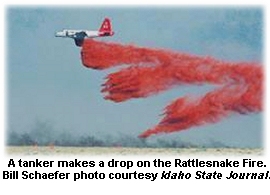 Joanna Wilson, fire information officer with the Eastern Idaho Interagency Fire Center, told the Idaho State Journal that the Rattlesnake Fire southwest of Pocatello was threatening several ranch buildings and had closed the Arbon Valley, Simplot, and Trail Creek roads. Joanna Wilson, fire information officer with the Eastern Idaho Interagency Fire Center, told the Idaho State Journal that the Rattlesnake Fire southwest of Pocatello was threatening several ranch buildings and had closed the Arbon Valley, Simplot, and Trail Creek roads.
The Sawmill Fire is northeast of Pocatello.
KPVI-TV reported that an ICP was set up near the Pocatello Airport.
The Pocatello municipal watershed is threatened, and crews reported that the fires are spreading primarily to the east. Portions of the fire are in steep and inaccessable terrain, and fire managers reported problems with unauthorized access into the fire area.
Suwyn's team has been coordinating firefighting goals with the Fort Hall Tribal Council. Almost 400 people are assigned to the fire, including 13 crews, four helicopters, 18 engines, and seven dozers.

NORTHWEST MONTANA FIRE 50 PERCENT CONTAINEDSEPTEMBER 04 -- PERMA, MT: Winds pushed the Seepay #2 Fire from about 3,000 acres earlier in the week to nearly 8,000 acres by last night. The fire's threatening about a half dozen homes and a powerline, and had earlier shut down Highway 200 because of smoke.
The Helena Independent Record reported that the fire's about 15 miles east of Plains, on the edge of the Flathead Indian Reservation.
Cowin's Type 2 team reported 50 percent containment last night on the 7,800-acre fire.
Steep rugged terrain with heavy fuel loadings could cause problems with containment today, and fire managers say they're counting on Type 1 crews and air support if the expected cold front arrives today. The fire's burning in heavy dead and down materials, with thick timber. About 675 people are on the fire.

GRANITE COMPLEX GETS TYPE 2 TEAMSEPTEMBER 04 -- RIGGINS, IDAHO: Lunde's Type 2 team took over the Granite Complex on the Idaho side of Hells Canyon this week, shifting from wildland fire use with limited suppression to a more ramped-up suppression strategy after the fire began threatening the management boundary.
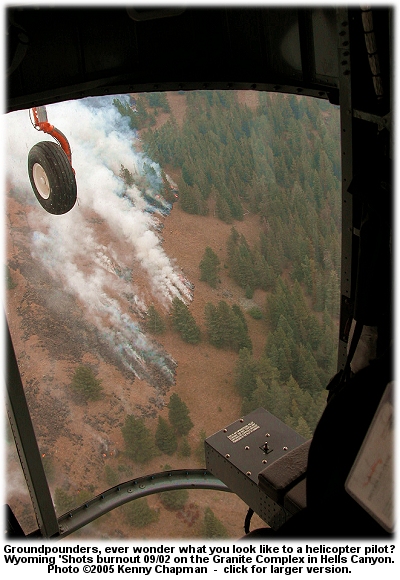 On Tuesday the fire was pushing 30,000 acres, and by last night it had reached almost 34,100 acres. On Tuesday the fire was pushing 30,000 acres, and by last night it had reached almost 34,100 acres.
The fire's been burning since August 7 about 30 miles east of Enterprise and 20 miles west of Riggins.
Last week the fire moved north across Sheep Creek and east into Lightning Creek and North Fork Lightning Creek, threatening to breach the wildland fire use management boundary on the northeast perimeter; fire managers decided to actively suppress the fire in that area.
Heavy helicopters have been dropping water and retardant on the fire, with hotshots on the ground securing fireline and burning out.
"Once a fire crosses that maximum boundary, you have 48 hours to get it back within the line," Information Officer Brian Miller told the La Grande Observer. "If you can't do that, you have to declare a wildfire."
The fire's about seven miles north of Hells Canyon Dam, and threatening four structures. Lunde's team plans to continue burnouts using aerial ignition reinforced by crews on the ground. They're also doing some structure protection assessment.
About 445 people are now on the fire, including ten hotshot crews, nine engines, and six helicopters.

SIGNAL ROCK FIRE AT 10,000 ACRESSEPTEMBER 04 -- PHILIPSBURG, MT: High winds earlier in the week kept helicopters on the ground and crews off the lines and forced officials to close the road over Skalkaho Pass -- which allowed the Signal Rock Fire to almost triple in size in one day.
Information Officer Ted Pettis told the Ravalli Republic that safety concerns outranked suppression efforts for a day. "There was so much smoke and fire, we couldn't get near it," he said. "You can't put people in front of 100-foot flames and expect them to be able to do anything."
Some crews were also pulled off the Signal Rock Fire to work on the Copper Creek Fire, burning at the creek's head in the Anaconda-Pintler Wilderness. That 70-acre fire could threaten properties near Moose Lake if heavy winds blew in.
The Signal Rock Fire was 5 percent contained last night at 10,000 acres. About 17 miles southwest of Philipsburg, it's burning in lodgepole and subalpine fir, and yesterday's crown runs and spotting caused the fire to grow by about 1,300 acres in just 24 hours. About 245 people are on the fire, which is being managed by Turman's Type 2 team.

TWO NEW IDAHO FIRESSEPTEMBER 04 -- MACKAY, IDAHO: A new fire in south-central Idaho yesterday was burning in the wilderness near Stanley and another was threatening up to 50 structures near the old mining town of Idaho City. An AP report in the Salt Lake Tribune said airtankers were diverted from the Idaho City fire to help on the one near Stanley.
The Gregory Fire southwest of Idaho City was at 150 acres with zero containment. Fire managers said red flag conditions today could cause the fire to threaten as many as 50 homes to the east of the fire, along with Idaho City and nearby powerlines. The fire is burning in heavy logging slash and tall dry grass; shifting winds yesterday were pushing the fire toward Idaho City.
About 170 people are on the fire, including firefighters from the Boise and Gem County rural fire departments and the Eagle City Fire Department.
The Wildhorse Fire had spread to about 160 acres by Saturday evening; zero containment was reported. Fire managers evacuated numerous campers from the Wildhorse Campground.
The Sunset Mountain Lookout spotted smoke from the fire about 1 p.m.
About 150 firefighters are on the fire, along with C-130 tankers out of Boise. Winds of up to 15 mph are forecast for today, with temperatures in the low 80s and RH of 10 percent.

FIRE NEAR GORMAN THREATENS 1,000 HOMESSEPTEMBER 03 -- GORMAN, CA: A fire that started today near Gorman had burned about 2,500 acres by 6 p.m. and was just 10 percent contained. About 1,000 homes are threatened, according to Dyer's L.A. County team, and evacuations were under way tonight with Frazier Park threatened.
One home and about three outbuildings were confirmed destroyed; NBC4-TV reported that two vehicles and a travel trailer were destroyed. L.A. County Fire Department Inspector Ron Haralson said Los Angeles and Kern county fire crews were on the fire, along with Los Angeles city firefighters and crews from the U.S. Forest Service and six fixed-wing USFS aircraft.
About 400 personnel are assigned. Firefighters reported that the fire was spotting and making runs at structures in light fuels, with pockets of heavy fuel.

PERRY APPROACHES $27,000SEPTEMBER 03 -- LANCASTER, CA: On September 10 -- that's next Saturday -- Kenneth Perry will set out from Fox Air Attack base at Lancaster for a 52-mile run to raise funds for the Wildland Firefighter Foundation.
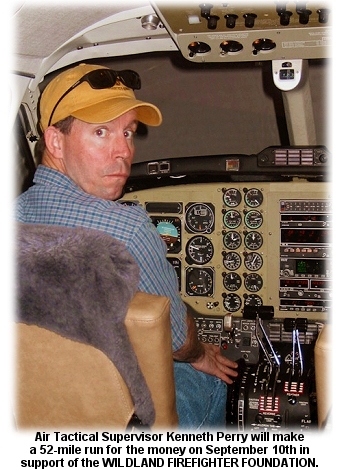 Pledges are being sought by the Foundation in support of Perry's "run for the money." Pledges are being sought by the Foundation in support of Perry's "run for the money."
An Air Tactical Supervisor for the BLM, Perry decided to make the run for the Foundation's 52 Club, the premise of which is to donate a buck a week to help injured firefighters or those killed in the line of duty and their families.
Perry's background includes smokejumping in Alaska and duty with the Fulton Hotshots on the Sequoia National Forest and the Kern County Fire Department. Five years ago he injured his back during a rescue operation in Alaska; even after a couple of surgeries he still deals with constant back and hip pain -- but he's found that long-distance running doesn't make his back any worse.
Perry and the Foundation are asking for pledges on a “per mile” basis in support of the 52-mile run, and today his fundraising potential for the 52 miles topped over $26,612. (!!!)
Notable pledges include Linda and Larry Shirley, who pledged $19.23 per mile "in loving memory of Retha," a pledge of $10 per mile from NorthTree Fire, another $10 per mile from Shawn Srader of the Hat Creek Ranger District on the Lassen, and numerous pledges from members of the SoCal IIMT #1 and SoCal IIMT #3 (award for IMT gang attack here -- you guys put the other teams to shame!!) and a real crew rally from the Chester Helishots. Smokejumpers are kicking in chunks of their paychecks, notably $5.77 per mile pledged from Wayne Risseeuw of the Redmond Smokejumpers, and a whopping $14 per mile from the McCall Smokejumpers (good on you jumpers there). The Arroyo Seco Crew #5 were all over the donation page in the last day or two, and the Redding jumpers were in this morning for another five bucks per mile, and Ron Bollier with the Fulton Hotshots put in $10.10 per mile! The Bear Divide Hotshots almost doubled that today with $20 per mile.
And then there's today's pledge from "The Colonel" on the GreenhornFire, an impressive $23.50 per mile. C'mon, crews and teams, that's over $1,200 from one fine fire colonel. Surely you teams and crews can give the old man a run for his money on Kenneth's run for his money? (grin)
Better than that even, we've got John Armstrong of the Texas Canyon IHC who pledged TWENTY-FIVE DOLLARS PER MILE today.
 Many pledges have been made in memory of fallen firefighters, and the aviation community makes a strong showing on the pledge list. Many pledges have been made in memory of fallen firefighters, and the aviation community makes a strong showing on the pledge list.
A referee will confirm the timing and distance of Perry's run, and pledges for funding to support the Foundation after the run will be sent directly to the Foundation. Spectators and cheerleaders and followers are encouraged. "If anyone happens to be in the area on that day," says Perry, "please feel free to stop by; spectators make great motivators!"
To make a pledge in support of Perry's run for the money, check the SUPPORT page on the Foundation website, and note on the form that you're pledging in support of Kenneth Perry's run. Check the pledge list and running totals at the pledge list page generously hosted by wildlandfire.com, or use their Pledge Entry Form for instant updates to the list. There are maps and other cool updated stuff about the run on that page, and further updates will be posted here and on the Foundation's news page at wffoundation.org/news and more information is available from the Foundation at (208)336-2996.
As of today Perry is earning about $512 per mile for the Foundation. His goal is to bring in $1,000 per mile, so get over there and sign up today!

NIFC SENDS CREWS SOUTHSEPTEMBER 01 -- BOISE, IDAHO: The National Interagency Fire Center has dispatched over 1,000 firefighters to the relief effort in the wake of Hurricane Katrina's devastation of the Gulf Coast. KTVB-TV reported that crews are being sent to base camps set up near the hurricane-wasted areas.
"Right now, we are trying to give as many resources as possible to the hurricane relief, while still maintaining the necessary firefighting capabilities in the West," said Phil Street with the U.S. Fish and Wildlife Service at NIFC. Four Type 1 teams have been deployed, and two more are expected to be sent in the next few days. Ten hand crews are working to clear debris, and NIFC expects to provide more crews, radios, and supplies. KIDK-TV reported that outside of the military, NIFC has the largest warehouse in the world of low-power and handheld radios, including satellite communications equipment. Steve Jenkins, chief of NIFC's Incident Communications Division, said they could immediately supply over 2,000 radios if needed.

FIRE THREATENS GRAND JUNCTION WATER SUPPLYSEPTEMBER 01 -- PALISADE, CO: A 426-acre fire at the base of Grand Mesa is threatening nine homes and the watershed that supplies Palisade and Grand Junction.
The Summit Daily News reported that crews were working to keep the Blowout Fire out of the watershed. The fire started late Tuesday on private land and spread to BLM land yesterday; Fowler's Type 3 team yesterday reported 10 percent containment, and a CBS-4 report said the fire had grown to 700 acres this morning.
The fire's burning in piñon-juniper, sage, and grass over steep and rocky terrain. Access is limited by poor roads, and some areas of the fire are inaccessible. The fire was actively crowning at 3 a.m. yesterday, with extreme fire behavior, torching, and active burning in flashy fuels.
The Rocky Mountain News reported that two SEATs and a heavy airtanker were dropping retardant to keep the fire from moving uphill on the mesa. More than 140 firefighters, two helicopters, a dozen engines, and a dozer are assigned.

BLAISDELL: FROM CAMPFIRE TO 5,000 ACRESAUGUST 29 -- PALM SPRINGS, CA: An escaped campfire northwest of Palm Springs tore across dry grass, pushed by hot dry winds through the San Jacinto Mountains, and temporarily evacuated the threatened community of Palm Oasis near the site where the fire started.
Garwood's Type 2 team reported this morning that the fire was 20 percent contained at 4,980 acres.
Residents were allowed to return to Palm Oasis yesterday after a voluntary evacuation. About 730 firefighters are assigned, along with seven airtankers, ten helicopters, 67 engines, and 12 water tenders. The fire's in steep and inaccessible areas of the upper reaches of Chino Canyon. Helicopter water drops are planned for today, and crews plan to use established helispots to cold-trail the accessible parts of the fire perimeter.
The Blaisdell Fire started when a campfire got out of control; three people were cited and could face fines for suppression costs.
The Palm Springs Desert Sun reported that fire forced officials to shut down the Palm Springs Aerial Tramway, but the cable cars and stations weren't damaged by the fire.

GRANITE COMPLEX NEARS 20,000 ACRESAUGUST 28 -- RIGGINS, IDAHO: The Granite Complex grew about 700 acres yesterday on the Idaho side of the Snake River in Hells Canyon; the complex is being managed as a Wildfire Use incident, but spot fires, increased fire behavior, and threats to Sheep Creek Cabin have prompted fire managers to actively fight portions of the fire.
The complex is about seven miles north of Hells Canyon Dam, in a very remote and inaccessible area. Late Friday afternoon and evening, the fire behavior picked up, and Cones's WFU team ordered four hotshot crews and a second heavy helicopter.

Multiple bucket drops near Sheep Creek on Friday stopped a spot fire, and half of a fire use module was combined with a squad of Malheur Rappellers to reinforce the bucket drops. The other half of the module worked on structure protection at Low Saddle Microwave Tower and the Cold
Springs Cow Camp.
Firefighters expect the fire to continue spreading to the northeast until significant rainfall occurs, and they expect continued active fire behavior in the areas below 4,000 feet elevation. Priorities include protecting the Sheep Creek Ranch Cabin and associated structures, and keeping the fire from crossing Sheep Creek toward the northern boundary of the Maximum Manageable Area (MMA), a fixed perimeter of the fire set by fire managers for "wildfire use." If the fire spreads beyond that MMA boundary, it's actively suppressed as a wildland fire.
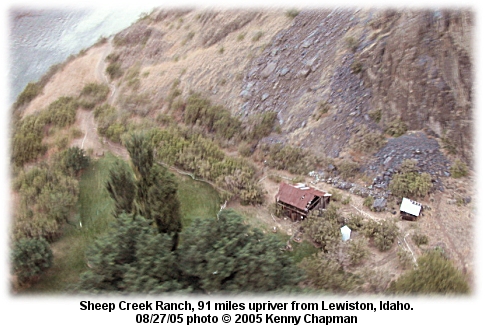
The Sheep Creek Ranch buildings are 1/8 mile east of the Snake River on Sheep Creek. The ranch is 91 miles upriver from Lewiston, Idaho; it's the last homestead reached by the jet boat mail run up the river. The ranch was established in 1913 by William McLeod, and the Forest Service acquired the property in the early 1970s. Snake River Adventures has been leasing it since 1985.
Forty-two people are assigned to the 18,687-acre fire; firefighters are expecting red flag conditions today.

CENTRAL OREGON FIRE EVACUATES 150 HOMESAUGUST 26 -- LaPine, OR: A fire this afternoon that quickly grew to over 100 acres evacuated the LaPine State Recreation Area and about 150 threatened homes to the south, according to KGW-TV. The Park Fire put up a plume that drifted north toward Bend and rained down ash on the park.
Oftentimes emergency shelters for residents evacuated from fire areas aren't close to filled, but the Red Cross reported that by 8 p.m. tonight about 90 people had checked in at LaPine Middle School.
Four airtankers made trips from the Redmond Air Center to drop on the fire till they ran out of daylight.

DEER CREEK FIRE THREATENS OVER 100 HOMESAUGUST 27 -- CAVE JUNCTION, OR: The 1,635-acre Deer Creek Fire just east of Selma was 40 percent contained this afternoon but still threatening more than 100 homes and about 125 other structures. Five homes were confirmed destroyed and another two were damaged, according to the Type 1 team managing the fire.
Hot, dry, and windy weather has contributed to the fire's spread and the difficulty in containing the fire, which is burning in heavy fuels in steep and rugged terrain. A dry cold front is expected tomorrow afternoon that could produce strong and shifting winds and threaten the firelines.
The evacuation of residential areas around the fire that was ordered yesterday was lifted at noon today, but a significant threat to structures still exists because of heavy fuels in the area and predicted weather. Crews this afternoon reported that all control lines were tied in and mop-up was under way on parts of the perimeter.
About 1,500 people are working on the fire, including the Illinois Valley Fire Department, Forest Service, CDF, Josephine County crews, and county sheriff's department personnel.

SW OREGON FIRE BURNS HOMES, EVACUATES 40 FAMILIESAUGUST 26 -- CAVE JUNCTION, OR: A wildfire east of Selma burned several homes yesterday and forced the evacuation of about 40 families; the Deer Creek Fire was spreading quickly in dry grass.
"It started as a three-acre grass fire," said Brian Ballou with the Oregon Department of Forestry, "and grew by leaps and bounds by the hour. It hasn’t been moved along by strong winds, but it just keeps finding fuel."
Last night three homes were confirmed lost along with 12 outbuildings; eight other structures were reported damaged. Fire managers reported this afternoon over 100 homes threatened.
The Josephine County sheriff’s department called for a voluntary evacuation after the fire destroyed homes, according to the Mail-Tribune. It's burning eight miles north of Cave Junction; a hot dry air mass that set up west of the Cascades yesterday afternoon, along with a high Haines Index, caused the fire to put up a huge convection column at about 8 p.m. The column was visible for miles and showed up on satellite imagery.
KVAL-TV reported today that the fire was "moving fast and furious" and that "the inferno blackened 1,800 acres of dense forest and at least four homes." KVAL-TV also noted that "800 more firefighters, including about one-hundred from the local group Skookum, were called out Friday to join the 200 already fighting the blaze."

AGGRESSIVE ATTACK STOPS SW OREGON FIREAUGUST 24 -- MEDFORD, OR: A fast-moving fire off Highway 140 near Lake Creek yesterday flared up an embankment along the highway, pushed by steady east winds on a dry day. The Jack Spring Fire grew to about 35 acres near the site of July’s 1,520-acre Wasson Fire; Brian Ballou with the Oregon Department of Forestry said it was burning in an area with a heavy fuels load of old logging slash.
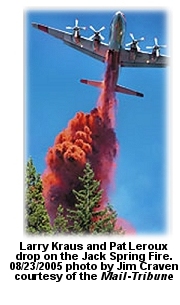 Two ODF crews hiked up the ridge to work the fire, and the highway was shut down briefly as an airtanker hit the fire with retardant. Three helicopters also dropped water on the fire, which was west of Lake of the Woods. Two ODF crews hiked up the ridge to work the fire, and the highway was shut down briefly as an airtanker hit the fire with retardant. Three helicopters also dropped water on the fire, which was west of Lake of the Woods.
"We’ve managed to get water around the whole fire," Ballou told the Mail-Tribune late in the day. "They’re going to continue hitting it with a lot of water."
He said ODF boosts resources sent to a known trouble area like the Highway 140 corridor this time of year; they dispatched 13 engines and two dozers, and Jackson County crews also responded.
Problematic weather is forecast for southwestern Oregon over the next two or three days. A frontal passage with gusty and strong steady winds yesterday moved across eastern Oregon and the Columbia Basin and caused flare-ups from lightning holdovers. Five of the 65+ starts reported since Sunday are currently staffed.
Two new large fires were reported yesterday in Oregon; the Fly Fire southwest of La Grande reported zero containment this morning at 500 acres. Burning in grass, timber, and slash, the fire spread rapidly yesterday with strong west/northwest winds for most of the afternoon. Short crown runs were a problem until airtankers and heavy helicopters working in unison were able to slow the spread toward nightfall. Goheen's Type 2 team has been ordered.
East of Frenchglen near Steens Mountain, the Fir Creek Fire is at 800 acres with zero containment. The fire made major runs yesterday, and airtankers worked till they ran out of daylight. Two major campgrounds and a number of primitive camping areas were evacuated.
Also, the Lakeview dispatch center reported that they're closely watching a 4,000-acre fire in northwestern Nevada called the Barrel Fire, which is bumping the border southeast of Adel, Oregon.

PILOT WALKS AWAY FROM SEAT CRASHAUGUST 24 -- ELKO, NV: A single-engine airtanker crashed yesterday afternoon while working the 6,800-acre Sherman Fire 15 miles north of Elko -- but the pilot walked away from the wreckage with minor injuries.
The SEAT was owned by Airwork Enterprises of Florida, with offices in both Texas and Florida, and was under contract with the BLM. The company owns three 660-gallon Turbine M18-A tankers, along with an 800-gallon AirTractor 802.
The Reno Gazette-Journal reported that the Sherman Fire is the largest of five started Monday by lightning in the area; it was 35 percent contained last night.
The Elko Daily Free Press called it a "ring of fire" around Elko. Bill Roach, dispatch center manager in Elko, said the local volunteer departments were scrambling. "For example, the Spring Creek Volunteer Fire Department put out ten fires in one day," he said. "They were discovering new fires on their way to others and dealt with them immediately. When the lightning storm moved through the area, we had fire reports from every direction."
Firefighting was difficult in the steep, rugged terrain, and there's limited access to the fire, which made a strong run toward the community of Ryndon and prompted an order for Muir's Type 2 team. They will take over the fire this evening.
The fire's burning in dormant brush and hardwood slash, grass, sage, bitterbrush, and juniper. About 260 people are on the fire.

22 OREGON CREWS SUSPENDEDAUGUST 22 -- BEND, OR: The Oregon Department of Forestry last week suspended 22 private firefighting crews across the state when it was determined that required permits for those crews had not been obtained by the firefighting contract companies that employ the crews.
"Somebody pulled strings in the middle of the fire season," said Rick Herson, owner of Oregon Woods Inc. of Eugene. "The loser in this deal is the taxpayers."
Oregon Woods is not listed as a member of the National Wildfire Suppession Association, a nonprofit association of firefighting companies.
The Bend Bulletin reported that some of the suspensions were based on information from a state lawmaker and Deschutes County Forester Joe Stutler, who said the crews were based in Deschutes, Josephine, and Jackson counties.
Complaints from Rep. Chuck Burley of Bend, along with Stutler, notified ODF officials that the crews had broken the terms of a state contract that's used to dispatch private crews in the Pacific Northwest. ODF staff oversee contract crews for the states of Washington and Oregon and the five federal agencies with firefighting responsibility. The rules require firefighting contract companies to obtain local government permits that allow them to dispatch firefighters. That rule's purpose is to certify the actual location in the state where the business is located, and was formulated in response to the previous practice -- by some contractors -- of setting up a temporary "business address" at a campground or other local site in order to receive dispatches in that part of the state. The crews that were suspended didn't have the required permits.
The new contract rules were partly a response to a series of fatal accidents involving firefighters driving long distances to and from fires, according to Grayback Forestry's Mike Wheelock.
In August last year, ODF terminated its agreement with contractors Mountain Forestry and Westwood Resources, Inc., over contract violations after investigations by the agency's Contract Services Unit. Independence-based Mountain Forestry was dropped from the 2004 Interagency Fire Crew Agreement when inspection of their training records uncovered falsified and undocumented records. Westwood Resources, a contractor with crews offered in Klamath Falls, was terminated for not having authorized dispatch locations.
The contract agreement prohibits dispatch locations from being changed once the bid solicitation for services has closed. Verified dispatch locations ensure that firefighters meet performance and work/rest standards, including traveling safely under conditions of the agreement.

CDF TESTS GELAUGUST 20 -- UKIAH, CA: It's new and it's blue and CDF's decided to use it statewide in the S2-T tankers. It's called Thermo-Gel, developed by Thermo Technologies, and has already been used on fires all over northern California.
The Ukiah Daily Journal reported that the gel concentrate, when mixed with water, adheres to any kind of surface, even vertical window panes. CDF did a test drive on the gel at Hemet-Ryan last fall. They dropped 22,880 gallons in 20 different drops over a testing period from August 14 till the first of October.
CDF has used the gel exclusively this fire season because of environmental concerns with retardant. The gel comes in different colors, but the base at Ukiah is using blue.
"The color is distinguishable on trees, grass, brush, and timber," said George Hall, former Ukiah Fire captain and division chief with All Terrain Fire Emergency Services, the company supplying the gel to the base.

PULASKI TRAIL DEDICATION TOMORROWAUGUST 19 -- WALLACE, IDAHO: On the afternoon of August 20, 1910, when the wind hit dozens of burning backcountry fires, the result was an inferno of almost unimaginable intensity. The fires merged till the flame front was 50 miles from side to side. Three million acres burned in two days, from north-central Idaho to northwest Montana. Five towns were destroyed, and at least 78 firefighters and seven civilians were killed.
Featured today in the Missoulian is the story of the U.S. Forest Service ranger named Ed Pulaski, who led 45 firefighters into a mine shaft, then stood guard at the entrance to turn back those who tried to flee in panic.
Tomorrow, 95 years after Ed Pulaski led his men to safety, the Forest Service will help dedicate a new trail to the old mine site. The trail was once well-worn by people and horses from Wallace to the St. Joe country, but over the decades the trail was forgotten and became overgrown. Jim See, who's been hiking the area's hills since the mid-1980s, said the trail was more or less abandoned, not even a true trail. But the more he learned about Pulaski's story and the fires of 1910, the more he became convinced that the trail was historically significant.
He and others launched the Pulaski Project, a private-public effort to negotiate easements across private lands along the trail, and secure a congressional appropriation of $300,000 and private funding of $147,000 for the trail.
See said there's not much evidence left of the 1910 fires along the trail, but interpretive signs along a two-mile route will tell the story.
Tomorrow's dedication ceremony will be held at the trailhead on Moon Pass Road just outside Wallace -- one of the Idaho towns devastated by the 1910 inferno. The trail itself is not yet open to the public, but should be fully open by October. The dedication's scheduled for 1 p.m. at the Pulaski Tunnel Trail trailhead. Note that there is NO PARKING available at the trailhead; school buses will pick up passengers at Wallace High School and the Northern Pacific Depot starting at 11:45 a.m. The same buses will return visitors after the ceremony.
For more information on the dedication and the project, check out the Pulaski Project website.

BLOSSOM 30 PERCENT CONTAINED TONIGHTAUGUST 18 -- MARIAL, OR: The spread of the Blossom Complex slowed some yesterday, and parts of the Rogue River were reopened to boaters and rafters. AP reports said the Rogue was reopened to commercial boaters in the nine miles from Grave Creek to Black Bar, but remained closed between there to Marial.
The fire was at 8,644 acres yesterday, up 255 acres from Tuesday, and it was at 9,124 acres tonight with 30 percent containment.
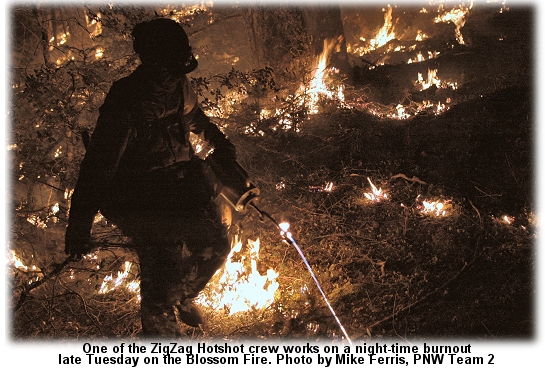
Crews finished building eight more miles of fireline and are continuing burnout operations. Last night only a few hot spots remained along the riverbank between Marial and Blossom Bar, and crews were working on firelines on the Big Meadow flank.
Resources this morning included 65 crews, 45 engines, 38 water tenders, and 10 helicopters.
Lohrey's Type 1 team reported tonight that 15 homes, four commercial properties, and almost 60 outbuildings have been threatened, including homes east of Mule Creek and at Paradise Lodge and Half Moon Lodge. Complex burning operations have been slowing containment efforts, but experts have been brought in; low fuel moistures and the potential for spotting have required carefully coordinated progression of the burnouts.

PERRY APPROACHES $9,000AUGUST 17 -- LANCASTER, CA: On September 10 Kenneth Perry will set out from Fox Air Attack base at Lancaster for a 52-mile run to raise funds for the Wildland Firefighter Foundation.
 Pledges are being sought by the Foundation in support of Perry's "run for the money." Pledges are being sought by the Foundation in support of Perry's "run for the money."
An Air Tactical Supervisor for the BLM, Perry decided to make the run for the Foundation's 52 Club, the premise of which is to donate a buck a week to help injured firefighters or those killed in the line of duty and their families.
Perry's background includes smokejumping in Alaska and duty with the Fulton Hotshots on the Sequoia National Forest and the Kern County Fire Department. Five years ago he injured his back during a rescue operation in Alaska; even after a couple of surgeries he still deals with constant back and hip pain -- but he's found that long-distance running doesn't make his back any worse.
Perry and the Foundation are asking for pledges on a “per mile” basis in support of the 52-mile run, and today his fundraising potential for the 52 miles topped over $8,800.
A referee will confirm the timing and distance of the run, and pledges will be sent directly to the Foundation.
Spectators and cheerleaders and followers are encouraged. "If anyone happens to be in the area on that day," says Perry, "please feel free to stop by; spectators make great motivators!"
To make a pledge in support of Perry's run for the money, check the SUPPORT page on the Foundation website, and note on the form that you're pledging in support of Kenneth Perry's run. Check the pledge list and running totals at the pledge list page generously hosted by wildlandfire.com, or use their Pledge Entry Form for instant updates to the list. Further updates and the run route will be posted here and on the Foundation's news page at wffoundation.org/news and more information is available from the Foundation at (208)336-2996.
As of today Perry is earning about $170 per mile for the Foundation. His goal is to bring in $1,000 per mile, so get over there and sign up today.
| 






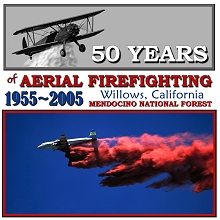



 OCTOBER 06 -- LANCASTER, CA:
OCTOBER 06 -- LANCASTER, CA:
 Ron Hvizdak, fire management officer on the Kootenai National Forest, has been using fire to fight fire for decades, but what happened on the Camp 32 Fire this summer dramatically illustrated how thinning and prescribed fire can stop a crowning wildfire.
Ron Hvizdak, fire management officer on the Kootenai National Forest, has been using fire to fight fire for decades, but what happened on the Camp 32 Fire this summer dramatically illustrated how thinning and prescribed fire can stop a crowning wildfire.
 Pledges are being sought by the Foundation in support of Perry's "run for the money."
Pledges are being sought by the Foundation in support of Perry's "run for the money."



 Pledges are being sought by the Foundation in support of Perry's "run for the money."
Pledges are being sought by the Foundation in support of Perry's "run for the money."




 Pledges are being sought by the Foundation in support of Perry's "run for the money."
Pledges are being sought by the Foundation in support of Perry's "run for the money."